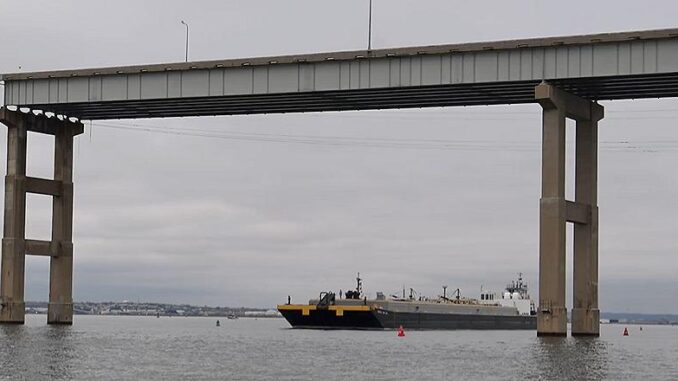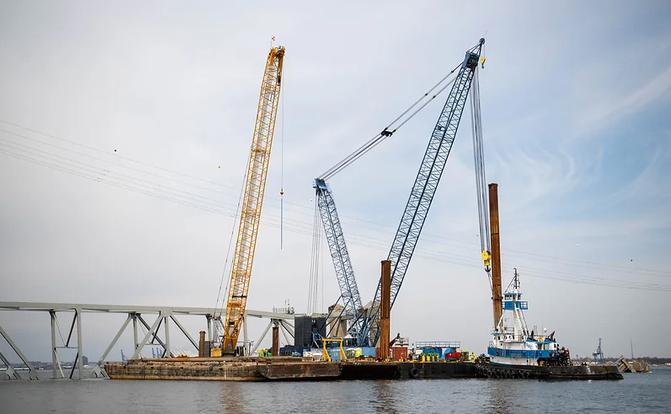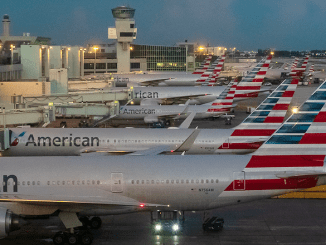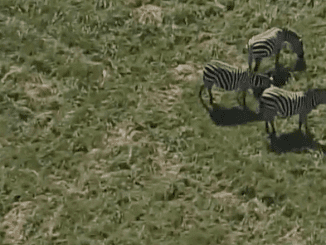
BALTIMORE, Maryland, April 2, 2024 (ENS) – The tugboat Crystal Coast pushing a fuel barge, sailed through the temporary alternate channel created by the Key Bridge Response Unified Command, at 3 pm Monday afternoon. It was the first vessel to use the channel since the Francis Scott Key Bridge, struck by a container ship, collapsed into the Patapsco River on March 26, killing six workmen, severing road and shipping transport across the river, and closing the busy Port of Baltimore.
The barge is used to supply jet fuel to the Department of Defense and was transiting to Dover Air Force Base in Delaware.
As part of a phased approach to opening the main federal river channel, the Captain of the Port, COPT, established the temporary alternate channel near Sollers Point for commercially-essential vessels.
This new temporary channel, marked with government-lighted aids to navigation, will be limited for transit at the discretion of the COTP and during daylight hours only. This temporary channel has a controlling depth of just 11 feet, a 264-foot horizontal clearance, and vertical clearance of 95 feet.
The Unified Command is working to establish a second, temporary alternate channel on the southwest side of the main channel. This second channel will allow for deeper draft vessels with an anticipated draft restriction of 15 to 16 feet.
Several cranes are now removing the wreckage of the Key bridge from the Patapsco River as the highway link provided by the bridge and the Port of Baltimore are critical to Maryland’s economy, to national and international supply chains, and to travel throughout the Northeast.

Classified by the U.S. Coast Guard as a major marine casualty, the National Transportation Safety Board, NTSB, is leading the investigation into the incident; the NTSB Office of Marine Safety is investigating and will establish the probable cause of the incident.
A 2,000-yard maritime Safety Zone for the Dali recovery efforts, a Temporary Flight Restriction with a radius of three nautical miles from the surface, up to and including 1,500 feet above ground level, remain in effect for protection of personnel, vessels, and the marine environment from the hazards associated with salvage work. The vessel remains stable with crew aboard, the Unified Command said.
The Key Bridge Response 2024 Unified Command includes the: U.S. Coast Guard, U.S. Army Corps of Engineers, Maryland Department of the Environment, Maryland Transportation Authority, Witt O’Brien’s representing Synergy Marine, and the Maryland State Police. Click here for incident response information.
How the Bridge Came Down
Shrouded in darkness, most Baltimore residents were asleep at 1:27 Tuesday morning when the Dali, a loaded cargo ship leaving the Port of Baltimore, lost its power and steering ability, striking a support structure of the Francis Scott Key Bridge on Highway I-695. The impact caused the 1.6 mile-long span to collapse into the Patapsco River at the mouth of Chesapeake Bay.
The four-lane bridge, which was used by some 30,000 vehicles a day, is now a mass of broken metal blocking the river. The busy Port of Baltimore, the top U.S. vehicle shipping hub, is closed to vessel traffic until further notice, and personnel from a dozen federal, state and local agencies are working to clear the wreckage safely and prevent an environmental catastrophe.
As it left the Port of Baltimore heading for Colombo, Sri Lanka under the control of two pilots and a nearly all-Indian crew, the 984-foot-long Singapore-flagged container ship Dali lost power and struck a primary support column of the bridge. The nearly 50-year-old bridge broke into pieces.

Moments before the crash, the ship issued a mayday call, giving Maryland Transportation Authority police time to halt traffic on both sides of the span, saving lives. One of the pilots radioed for tugboat help and reported a power loss moments earlier, federal safety officials said Wednesday, after hearing audio from the ship’s black box data recorder.
Rescuers pulled two workers from the water alive on Tuesday, and one was hospitalized, while the other walked away.
But six repaving workers were still on the bridge at the time it collapsed, repairing the roadway surface. They were hurled into the water. Divers on Wednesday recovered the remains of two of the six lost workers, Alejandro Hernandez Fuentes, 35, of Baltimore, a native of Mexico; and Dorlian Ronial Castillo Cabrera, 26, of Dundalk, Maryland, originally from Guatemala.
Maryland State Police Colonel Roland Butler said a red pickup truck containing the bodies of the two men was found in about 25 feet (7.62 m) of water near the mid-section of the fallen bridge. Four other repaving workers, including immigrants from Honduras and El Salvador, are still missing and presumed dead, authorities said.
Authorities have suspended efforts to retrieve more bodies from the depths due to visibility of just a few inches, sharp and heavy objects underwater, potential harmful substances in the water = extremely dangerous conditions for divers. Sonar images showed some submerged vehicles “encased” in sunken bridge debris, making them even tougher to reach, Butler said.
Keeping Pollutants Out of the Water
One important issue now is the potential for environmental pollution of the Patapsco River, and potentially Chesapeake Bay, even though the NTSB said Thursday that they had received no reports of pollution at that time.
U.S. Coast Guard Vice Admiral Peter Gautier, deputy commandant for operations, came out of an Oval Office meeting Wednesday morning with President Joe Biden and transportation officials announcing that the 984-foot-long Singapore-flagged container ship Dali had 4,700 cargo containers on board, 56 of them loaded with hazardous materials.
“In terms of continuing to stabilize the vessel, mitigating any pollution threat, and removing the vessel from the area, the vessel is stable, but it still has over 1.5 million gallons of fuel oil and lube oil onboard,” Gautier said then.
Two containers are missing overboard, Gautier said, but the ones in the water “do not contain hazardous materials.” Yet, 14 containers on the bow of the Dali were damaged as the stricken bridge collapsed onto the front of the ship.
Even so, a “sheen” was observed on the water by the head of the NTSB herself. Chair Jennifer Homendy said some of the containers aboard the ship containing hazardous materials had been breached.
She and other officials could see “sheen” on the water Wednesday, she told a news conference that evening. Cleanup efforts will be determined by agencies other than hers, Homendy said.
Baltimore uses surface water from rainfall and snowmelt as the source of its water. The city’s water supply system consists of three major sources: Gunpowder Falls, North Branch Patapsco River and the Susquehanna River. Three reservoirs outside city limits gather and store drinking water.
The Maryland Department of the Environment is conducting water sampling around the incident site, working with the U.S. Coast Guard and other agencies. The U.S. Fish and Wildlife Service is standing by in case there is a need to deploy oil spill protocols.
Funding, Debris Removal and Damage Control
“Initial damage estimates to the vessel and the bridge exceed $500,000,” the NTSB said Thursday.
The cost to replace the critical structure is not yet known, but within hours of receiving a request for emergency funding on Thursday, the U.S. Department of Transportation’s Federal Highway Administration, FHWA, announced the immediate availability of $60 million in “quick release” emergency relief funds for the Maryland Department of Transportation to rebuild the Francis Scott Key Bridge.
“President Biden and all our federal partners have given Maryland tremendous support as we face an overwhelming tragedy impacting our state, our region and the people of Baltimore,” said Maryland Governor Wes Moore. “This initial emergency relief request is needed for our immediate response efforts, and to lay the foundation for a rapid recovery.”
The Key Bridge over the Patapsco River provided a critical transport link connecting four major Eastern cities: Baltimore and Washington, DC, as well as Philadelphia and New York.
President Biden, who hails from the neighboring state of Delaware, has announced that the federal government will cover the costs for rebuilding the bridge, and he has directed that the port be reopened swiftly.
“It’s the top port in America for both imports and exports of automobiles and light trucks. Around 850,000 vehicles go through that port every single year, and we’re going to get it up and running again as soon as possible,” the President said.
“It’s my intention that the federal government will pay for the entire cost of reconstructing that bridge,” Biden said Tuesday. “I expect Congress to support my effort.”
When asked if the owners of the ship that struck the bridge should pay for any of the costs, Biden replied, “We’re not going to wait for that to happen.”

The initial $60 million in funding is a down payment toward initial costs, and more Emergency Relief program funding will be made available as work continues.
Transportation Secretary Pete Buttigieg said, “No one will ever forget the shocking images of a container vessel striking the Francis Scott Key Bridge, causing its collapse and the tragic loss of six people. “The federal emergency funds we’re releasing today will help Maryland begin urgent work, to be followed by further resources as recovery and rebuilding efforts progress.”
“President Biden has been clear: the federal government will do everything it takes to help rebuild the bridge and get the Port of Baltimore back open,” Buttigeig said.
On Saturday, highly trained demolition crews began cutting the top portion of the north side of the collapsed bridge into smaller sections for removal by crane as one crane barge and one working barge arrived at the incident site to support Saturday’s operations.
Today, two crane barges, a 650-ton crane and a 330-ton crane, are actively working at the site. The removed wreckage is being lifted and transferred to a barge. A 230-ton land-based crane will offload and process the wreckage at Tradepoint Atlantic’s global logistics center.
“Salvage teams will use gas-powered cutters to systematically separate sections of the steel bridge, which will be taken to a disposal site. At the same time, salvage divers continue to conduct underwater assessments of the work site to support further operations. Every lifting operation requires engineering analysis to inform salvage operation plans,” Command officials explained.
The Unified Command is working in partnership with Baltimore Gas and Electric Company, BGE, to reduce the pressure of an underwater pipeline that spans the width of the channel and runs under the incident site.
BGE has reduced pressure of the underwater natural gas pipeline to 35psi. The pipeline spans the width of the channel and runs under the incident site. The Unified Command is continuing to coordinate with BGE to inert the pipeline to free it from hazards and risk. Pipeline operations continue through the weekend.
Three dive teams with the Unified Command are surveying sections of the bridge and the M/V Dali for future removal operations.
A Debris Reporting Hotline has been established. If any member of the public encounters debris from the incident, please contact +1 (410) 205-6625
“Consistent with the President’s direction to get the port up and running as soon as possible, the Coast Guard highest priority now is restoring the waterway for shipping, stabilizing the motor vessel Dali and removing it from the site, and coordinating a maritime casualty investigation under the leadership of the National Transportation and Safety Board,” Vice Admiral Gautier told reporters.
The Key Bridge Response Unified Command lists its priorities as, “ensuring the safety of the public and first responders, accountability of missing persons, safely restoring transportation infrastructure and commerce, protecting the environment, and supporting the investigation.”
NTSB Chair Homendy told reporters that the Francis Scott Key Bridge, while deemed to be in “satisfactory” condition from its most recent inspection in 2023, was constructed in such a manner that failure of one structural member “would likely cause a portion of, or the entire bridge to collapse.” The bridge lacked structural engineering redundancies built into newer bridges, she said.
Engineers are of two minds on the adequacy of protection for the bridge before the crash. It appeared to have pier-protecting structures in place, but there is debate among engineers as to whether more could have been done to shield against the direct impact of the massive ship that brought the bridge down.
But the bridge was built in 1977 at a time when a ship the size of the 984-foot Dali container vessel could not have been anticipated, the American Society of Civil Engineers’ 2020 President K.N. Gunalan, (Guna) said.
“The disaster will no doubt change the way bridges are designed, built and protected,” Guna said.
Help for the Port of Baltimore
Until this crash, the Port of Baltimore was thriving, setting cargo records, generating about 15,300 direct jobs, with nearly 140,000 other jobs linked to port activities. It ranks first among the nation’s ports for volume of autos and light trucks, as well as roll on/roll off heavy farm and construction machinery.
“The Port of Baltimore is a key component in Maryland’s transportation network,” said Maryland Department of Transportation Secretary Paul Wiedefeld. “Our strong highway and rail infrastructure
network, coupled with the port’s great labor force and strong regional supply chain, allows us to move goods efficiently and get them to consumers quickly.” But Wiedefeld made that remark on February 23, 2024, while announcing that the port had handled a record 52.3 million tons of foreign cargo worth $80 billion, in 2023. How quickly things can change.

“This is a unique circumstance,” said Secretary Buttigieg. “I do not know of a bridge that has been constructed to withstand a direct impact from a vessel of this size.”
But some corporations are nimble in the face of restricted shipping. MarineTraffic is indicating that in the past 48 hours up to 14 vessels have signaled a change in destination. Among them are two vehicle carriers, the RCC Classic and the Grand Torino, ships that have now changed their destinations from Baltimore to the Port of Wilmington, North Carolina.
The automobile manufacturers are quickly making adjustments to the changing circumstances.
General Motors said in a statement, “We expect the situation to have minimal impact to our operations. We are working to re-route any vehicle shipments to other ports.”
Ford Chief Financial Officer John Lawler told Bloomberg News, “We’ll have to divert parts to other ports… It will probably lengthen the supply chain a bit.”
Other East Coast ports that might handle rerouted vessels are the Port of New York and New Jersey to the north, and the Port of Savannah in Georgia to the south.
But America has lost one of its great bridges, Secretary Buttigieg said, pledging to raise the Francis Scott Key Bridge once again. “This is one of the cathedrals of American infrastructure,” he declared. “It has been part of the skyline of this region for longer than many of us had been alive. The path to normalcy will not be easy. It will not be quick. It will not be inexpensive, but we will rebuild together.”
Featured image: The tugboat Crystal Coast pushes a fuel barge through the temporary alternate channel near the Key Bridge incident, in Baltimore, Maryland, April 1, 2024. (Screengrab from U.S. Coast Guard video by Petty Officer 2nd Class Taylor Bacon)



